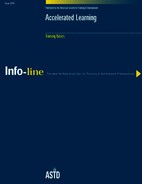Presentation
The presentation phase of this methodology entails numerous elements that enhance the learning environment, including the following:
Positive Suggestions
Positive suggestions can release barriers to learning, focusing the learner on possibility rather than limitation. Positive suggestions provide external direction to the way in which a person represents objects and experiences in his or her mind. The brain is more receptive and less guarded in a supportive learning community. Images of enjoyment and success, benefits from mastering the material, and positive expectations all contribute to a positive outcome.
Music
Music creates a calm but alert state conducive for rapid assimilation of information. The heart and breathing rates tend to synchronize with the beat of the music. Lozanov found that baroque compositions (known as largo or adagio), which play approximately 60 beats per minute, mirror the human heart rate in a relaxed state. Deliberate breathing techniques are another method used to create this learning state. For more music suggestions, see Music as a Learning Accelerator.
Previews
Course overviews and concept previews help to organize and link new information.
Active Presentation
Analogies, metaphors, mental imagery, colorful graphics, and visuals strengthen learning through sensory stimulation and associations. Use vivid language, dramatic gestures, vocal variety, physical objects, and props.
Collaboration
Groups, learner presentations, self-discovery exercises, skits, role plays, songs, and games engage learners and tap group energy.
Peer Teaching
Pairing of learners for alternating teaching and learning from each other is useful for grouping large classes into small learning cells. These pairings reduce anxiety at the beginning of the course, involve all members in the learning process, explore a subject in greater depth than a large group discussion allows, and provide immediate feedback and self-assessment of learning.
Mind Mapping
Also known as information graphing or memory mapping, this is a powerful technique for engaging the whole brain. Mind maps stimulate creativity and illustrate where the parts fit in the whole. They can be used to outline the course, illustrate a process, take notes, brainstorm, create a job aid, and review content. Mind maps use both color and images.
